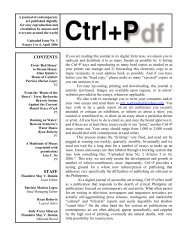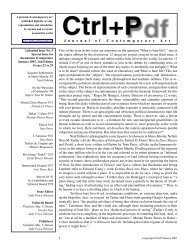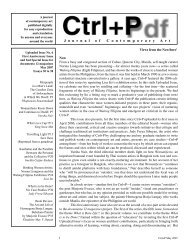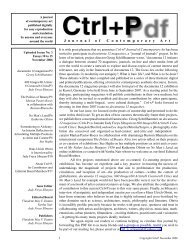Issue 15 - Pdf Ctrl+P - CTRL+P: a journal of contemporary art
Issue 15 - Pdf Ctrl+P - CTRL+P: a journal of contemporary art
Issue 15 - Pdf Ctrl+P - CTRL+P: a journal of contemporary art
Create successful ePaper yourself
Turn your PDF publications into a flip-book with our unique Google optimized e-Paper software.
Installation view “Best <strong>of</strong> Discovery”,<br />
SH<strong>contemporary</strong>08 <strong>art</strong> fair, Shanghai<br />
Photo credits: Gina Fairley<br />
Jing Shijian (China).“Express<br />
Train: Shanghai Biennale Station”<br />
(2008). Train car, rail, sleepers,<br />
video, 45 tonnes. Installation view<br />
7th Shanghai Biennale, 2008<br />
Photo credits: Gina Fairley<br />
This explosion is not specific to China. Between 2006 and 2008 the number <strong>of</strong> <strong>art</strong><br />
fairs rocketed with 50 held in 2008 alone; 21 <strong>of</strong> those were held in Asia. Former Editor<br />
at Art Asia Pacific Andrew Maerkle notes that, “…galleries from the Asia-Pacific region<br />
still represent less than 1% <strong>of</strong> international <strong>art</strong> fair exhibitors.” 5<br />
While this statistic may be true it does not reflect the number<br />
<strong>of</strong> Asian <strong>art</strong>ists shown at these events, regardless <strong>of</strong> the location<br />
<strong>of</strong> the gallery.<br />
What is more interesting than the global power structures<br />
<strong>of</strong> <strong>art</strong> fairs is the way they are redefining themselves, bridging<br />
if you like, biennales and auctions with curated components<br />
and commissioned works by ‘celebrity <strong>art</strong>ists’ featured within<br />
their selling halls. Shanghai’s SHContemporary, for example,<br />
calls theirs “Best <strong>of</strong> Discovery.” The choice <strong>of</strong> name says it all<br />
playing <strong>of</strong>f the speculation or savvy discovery <strong>of</strong> the new that<br />
has skewed the market <strong>of</strong> recent years. It is a curious tension<br />
between elite market drivers and popular interest.<br />
And with the growing trend <strong>of</strong> biennales and triennials<br />
to commission work for institutional collections—one only<br />
has to recall that the Fifth Asia Pacific Triennial commissioned<br />
or acquired 70% <strong>of</strong> its works prior to the exhibition’s<br />
opening—one ponders whether next we will have the ‘buying<br />
biennale’? One might even ask whether the biennale has<br />
hijacked <strong>contemporary</strong> <strong>art</strong> making, so thoroughly massaged and hyped that they have<br />
backed themselves into a corner <strong>of</strong> staged dialogues and price tickets, and <strong>art</strong> fairs are<br />
quickly filling the fissures.<br />
A further interesting trend is the shift in several <strong>of</strong> these Asian events from a locally<br />
focused survey <strong>of</strong> the ‘new’ addressing their own <strong>art</strong> scene to become International exhibitions<br />
turning towards global trends. Shanghai, Guangzhou, Taipei, Busan, Gwangju,<br />
Yogyak<strong>art</strong>a and Jak<strong>art</strong>a have all made this shift, the most recent being the XIII Jak<strong>art</strong>a<br />
Biennale just this February despite st<strong>art</strong>ing in the 1960s as a painting show. It indicates<br />
to me where these <strong>art</strong> scenes are setting their sites.<br />
Yongwoo Lee <strong>of</strong> last year’s Gwangju Biennale, however, disagrees. He speaks<br />
<strong>of</strong> Korea’s embrace <strong>of</strong> this biennalisation: “The biennale culture <strong>of</strong> Korea has already<br />
accumulated 13 years <strong>of</strong> experience and is constantly expanding, quantitatively. I do<br />
not believe that it comes from the system <strong>of</strong> the biennale or structure<br />
<strong>of</strong> global production it conveys...I anticipate the emergence <strong>of</strong> a new<br />
ideology and international styles <strong>of</strong> <strong>art</strong> in the niches <strong>of</strong> the economic<br />
crisis and recess.” 6<br />
Lee believes the needs and local desires <strong>of</strong> individual nations are<br />
driving this beast. If the impact <strong>of</strong> the GEC can be weathered by these<br />
events and <strong>of</strong>fer a reshuffling the deck <strong>of</strong> speculators, their 2010 versions<br />
will be the real barometer to their longevity as a vital curatorial model.<br />
It begs the old question to again be asked: Who really are these Asian<br />
biennales for and how do we filter their curatorial choices?<br />
Remapping/geopolitics<br />
2008 was the year to catch the Asian biennale and I managed to do<br />
my share, regularly opting to see these exhibitions outside the ‘opening<br />
week caravan.’ What became apparent to me were two very different<br />
experiences <strong>of</strong> the same exhibition: One attempting to satisfy global <strong>art</strong><br />
vernacular; the other trying to grow these events to a local population.<br />
What currency does the voice <strong>of</strong> the nomadic curator have to this<br />
local population, where he or she steps centre stage for a short moment?<br />
As ‘the biennale’ has been deployed across cities and regions, these events<br />
increasingly are brokered on themes <strong>of</strong> social responsibility as witness to<br />
12 <strong>Ctrl+P</strong> September 2009







